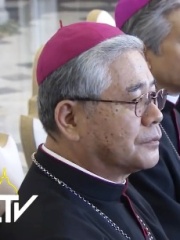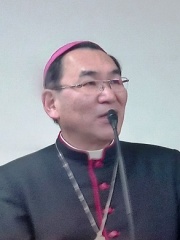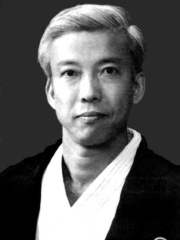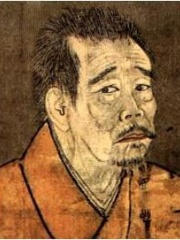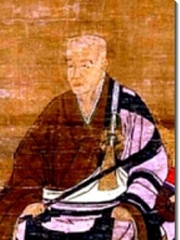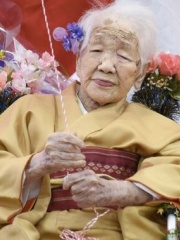
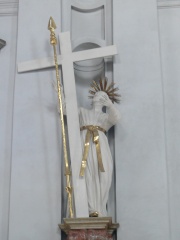
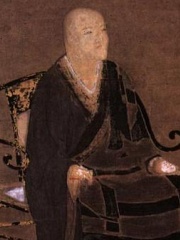

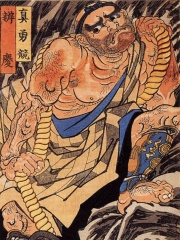
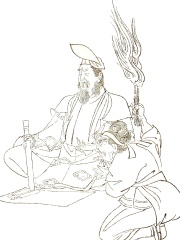
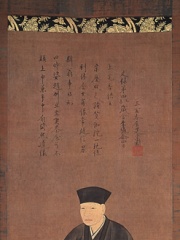
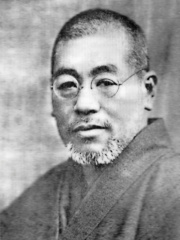
The Most Famous
RELIGIOUS FIGURES from Japan
This page contains a list of the greatest Japanese Religious Figures. The pantheon dataset contains 3,187 Religious Figures, 33 of which were born in Japan. This makes Japan the birth place of the 17th most number of Religious Figures behind Iraq, and Iran.
Top 10
The following people are considered by Pantheon to be the top 10 most legendary Japanese Religious Figures of all time. This list of famous Japanese Religious Figures is sorted by HPI (Historical Popularity Index), a metric that aggregates information on a biography's online popularity. Visit the rankings page to view the entire list of Japanese Religious Figures.

1. Kane Tanaka (1903 - 2022)
With an HPI of 72.71, Kane Tanaka is the most famous Japanese Religious Figure. Her biography has been translated into 42 different languages on wikipedia.
Kane Tanaka (田中 カ子, Tanaka Kane; née Ōta (太田); 2 January 1903 – 19 April 2022) was a Japanese supercentenarian who, until her death at the age of 119 years, 107 days, was the world's oldest verified living person, following the death of Chiyo Miyako on 22 July 2018. She is the oldest verified Japanese person and the second-oldest verified person ever, after Jeanne Calment.

2. Paulo Miki (1564 - 1597)
With an HPI of 72.48, Paulo Miki is the 2nd most famous Japanese Religious Figure. His biography has been translated into 28 different languages.
Paul Miki, SJ (Japanese: パウロ三木; (‘Paulo Miki’) c. 1562 – 5 February 1597) was a Japanese Catholic evangelist and Jesuit, known for his martyrdom during a 16th-century anti-Catholic uprising. Canonized by Pope Pius IX in 1862, Miki is recognized as one of the Twenty-six Martyrs of Japan.

3. Dōgen (1200 - 1253)
With an HPI of 72.38, Dōgen is the 3rd most famous Japanese Religious Figure. His biography has been translated into 43 different languages.
Dōgen Zenji (道元禅師; Japanese pronunciation: [doꜜː.ɡeɴ, -ŋeɴ], 26 January 1200 – 22 September 1253) was a Japanese Zen Buddhist monk, writer, poet, philosopher, and founder of the Sōtō school of Zen in Japan. He is also known as Dōgen Kigen (道元希玄), Eihei Dōgen (永平道元), Kōso Jōyō Daishi (高祖承陽大師), and Busshō Dentō Kokushi (仏性伝東国師). Originally ordained as a monk in the Tendai School in Kyoto, he was ultimately dissatisfied with its teaching and traveled to China to seek out what he believed to be a more authentic Buddhism. He remained there for four years, finally training under Tiāntóng Rújìng, an eminent teacher of the Cáodòng lineage of Chinese Chan. Upon his return to Japan, he began promoting the practice of zazen (sitting meditation) through literary works such as Fukanzazengi and Bendōwa. He eventually broke relations completely with the powerful Tendai School, and, after several years of likely friction between himself and the establishment, left Kyoto for the mountainous countryside where he founded the monastery Eihei-ji, which remains the head temple of the Sōtō school today. Dōgen is known for his extensive writings like the Shōbōgenzō (Treasury of the True Dharma Eye, considered his magnum opus), the Eihei Kōroku (Extensive Record, a collection of his talks), the Eihei Shingi (the first Japanese Zen monastic code), along with his Japanese poetry, and commentaries. Dōgen's writings are one of the most important sources studied in the contemporary Sōtō Zen tradition.

4. Nichiren (1222 - 1282)
With an HPI of 72.08, Nichiren is the 4th most famous Japanese Religious Figure. His biography has been translated into 42 different languages.
Nichiren (日蓮; Japanese pronunciation: [ɲi.tɕiꜜ.ɾeɴ, ɲiꜜ.tɕi.ɾeɴ], 6 April 1222 – 13 October 1282) was a Japanese Buddhist monk and philosopher of the Kamakura period. His teachings form the basis of Nichiren Buddhism, a unique branch of Japanese Mahayana Buddhism based on the Lotus Sutra. Nichiren declared that the Lotus Sutra alone contains the highest truth of Buddhism and that it is the only sutra suited for the Age of Dharma Decline. He insisted that the sovereign of Japan and its people should support only this form of Buddhism and eradicate all others, or they would face social collapse and environmental disasters. Nichiren advocated the faithful recitation of the title of the Lotus Sutra, Namu Myōhō Renge Kyō, as the only effective path to Buddhahood in this very life, a path which he saw as accessible to all people regardless of class, education or ability. Nichiren held that Shakyamuni and all other Buddhist deities were manifestations of the Original Eternal Buddha (本仏 Honbutsu) of the Lotus Sutra, which he equated with the Lotus Sutra itself and its title. He also declared that believers of the Lotus Sutra must propagate it even though this would lead to many difficulties and even persecution, which Nichiren understood as a way of "reading" the Lotus Sutra with one's very body. Nichiren believed that the spread of the Lotus Sutra teachings would lead to the creation of a Pure Land on earth. Nichiren was a prolific writer and his biography, temperament, and the evolution of his beliefs has been gleaned primarily from his writings. He claimed to be the reincarnation of bodhisattva Viśiṣṭacāritra (Jōgyō), and designated six senior disciples, which later led to much disagreement after his death. Nichiren's harsh critiques of the Buddhist establishment led to many persecutions against him and his followers. He was exiled twice and some of his followers were imprisoned or killed. After his death, Nichiren’s followers continued to grow, making it one of Japan's largest Buddhist traditions. He was posthumously bestowed the title Nichiren Dai-Bosatsu (日蓮大菩薩; Great Bodhisattva Nichiren) by the Emperor Go-Kōgon in 1358. The title Risshō Daishi (立正大師; Great Teacher of Correction) was also later conferred by the Emperor Taishō in 1922. Nichiren Buddhism today includes more than forty different officially registered organizations, some of which have significant international presence. These include traditional temple schools such as Nichiren-shū sects and Nichiren Shōshū, as well as modern lay movements such as Soka Gakkai, Risshō Kōsei Kai, Reiyūkai, Kenshōkai, Honmon Butsuryū-shū, Kempon Hokke, and Shōshinkai among many others. Each group has varying views of Nichiren's teachings, some being more exclusivist than the others. Some see Nichiren as being the Bodhisattva Viśiṣṭacāritra, while other sects claim that Nichiren was actually the Primordial or "True Buddha" (本仏, Honbutsu).
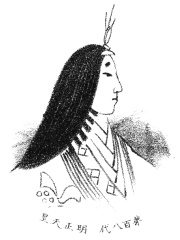
5. Empress Meishō (1624 - 1696)
With an HPI of 70.84, Empress Meishō is the 5th most famous Japanese Religious Figure. Her biography has been translated into 41 different languages.
Okiko (Japanese: 興子), posthumously honored as Empress Meishō (明正天皇, Meishō-tennō; January 9, 1624 – December 4, 1696), was the 109th monarch of Japan, according to the traditional order of succession. Her reign lasted from 1629 to 1643. Her reign officially began when she was five years old and continued for fifteen years. It is believed that Meishō's father actually ruled in her name until she abdicated in favor of her younger half-brother. In the history of Japan, Meishō was the seventh of eight women to become empress regnant. The six who reigned before her were Suiko, Kōgyoku/Saimei, Jitō, Genmei, Genshō, and Kōken/Shōtoku. Her sole female successor was Go-Sakuramachi.

6. Benkei (1155 - 1189)
With an HPI of 70.14, Benkei is the 6th most famous Japanese Religious Figure. His biography has been translated into 30 different languages.
Saitō Musashibō Benkei (西塔 武蔵坊 弁慶; Japanese pronunciation: [mɯ.sa.ɕiꜜ.boː | beꜜŋ.kei, -keː] 1155–1189), popularly known by the mononym Benkei ([beꜜŋ.kei, -keː]), was a Japanese warrior monk (sōhei) who lived in the latter years of the Heian Period (794–1185). Benkei led a varied life, first becoming a monk, then a mountain ascetic, and then a rogue warrior. He later came to respect and serve the famous warrior Minamoto no Yoshitsune, also known as Ushiwakamaru. He is commonly depicted as a man of great strength and loyalty, and a popular subject of Japanese folklore showcased in many ancient and modern literature and productions. The earliest records of Benkei are in the Azuma Kagami, The Tale of the Heike, and the Genpei Jōsuiki—all sources from around a century or more after Benkei's life. These sources generally only indicate Benkei was one of Yoshitsune's retainers and was a thin monk, although they do indicate Yoshitsune was aided and protected by a band of rogueish sōhei (warrior-monks) near Mount Hiei after he fled the capital—perhaps the historical core of the Benkei legend. Many of the detailed anecdotes and stories of Benkei are from the Gikeiki, an even later 14th-century work. As no contemporary records of Benkei are extant, it is difficult to know which elements of the stories are historical and which are embellished.

7. Abe no Seimei (921 - 1005)
With an HPI of 69.22, Abe no Seimei is the 7th most famous Japanese Religious Figure. His biography has been translated into 22 different languages.
Abe no Seimei (安倍 晴明; February 21, 921 AD – October 31, 1005) was a Japanese onmyōji, a court official and specialist of Onmyōdō, during the middle of the Heian period. In addition to his prominence in history, he is a legendary figure in Japanese folklore. He has been portrayed in several stories and films. Seimei worked as an onmyōji for emperors and the Heian government, advising on the spiritually correct way to deal with issues. He prayed for the well-being of emperors and the government and advised on various issues. He was also an astrologer and predicted astrological events. He lived a long life of 84 years, free from any major illness, contributing to the popular belief that he had mystical powers. The Seimei Shrine, located in Kyoto, is dedicated to him. The Abeno train station and district in Osaka are named after him, as it is one of the locations where legends place his birth.

8. Sen no Rikyū (1522 - 1591)
With an HPI of 69.18, Sen no Rikyū is the 8th most famous Japanese Religious Figure. His biography has been translated into 31 different languages.
Sen no Rikyū (Japanese: 千 利休; 1522 – April 21, 1591), also known simply as Rikyū, was a Japanese tea master considered the most important influence on the chanoyu, the Japanese "Way of Tea", particularly the tradition of wabi-cha. He was also the first to emphasize several key aspects of the ceremony, including rustic simplicity, directness of approach and honesty of self. Originating from the Sengoku and Azuchi–Momoyama periods, these aspects of the tea ceremony persist. There are three iemoto (sōke), or 'head houses' of the Japanese Way of Tea, that are directly descended from Rikyū: the Omotesenke, Urasenke, and Mushakōjisenke, all three of which are dedicated to passing forward the teachings of their mutual family founder, Rikyū. They are collectively called san senke.

9. Mikao Usui (1865 - 1926)
With an HPI of 67.34, Mikao Usui is the 9th most famous Japanese Religious Figure. His biography has been translated into 27 different languages.
Mikao Usui (臼井甕男, 15 August 1865 – 9 March 1926, commonly Usui Mikao in Japanese) was the father of a form of energy medicine and spiritual practice known as Reiki, used as an alternative therapy for the treatment of physical, emotional, and mental diseases. According to the inscription on his memorial stone, Usui taught Reiki to over 2,000 people during his lifetime. Eleven of these students continued their training to reach the Shinpiden level, a level equivalent to the Western third degree, or Master level.
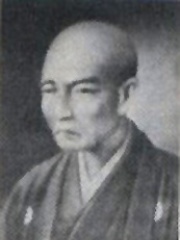
10. Yamamoto Tsunetomo (1659 - 1719)
With an HPI of 66.14, Yamamoto Tsunetomo is the 10th most famous Japanese Religious Figure. His biography has been translated into 21 different languages.
Yamamoto Tsunetomo (山本 常朝), Buddhist monastic name Yamamoto Jōchō (June 11, 1659 – November 30, 1719), was a samurai of the Saga Domain in Hizen Province under his lord Nabeshima Mitsushige. He became a Zen Buddhist priest and relayed his experiences, memories, lessons, ideas, and aphorisms to the samurai Tashiro Tsuramoto, who compiled them under the title Hagakure.
People
Pantheon has 33 people classified as Japanese religious figures born between 551 and 1958. Of these 33, 3 (9.09%) of them are still alive today. The most famous living Japanese religious figures include Thomas Aquino Manyo Maeda, Tarcisio Isao Kikuchi, and Moriteru Ueshiba. The most famous deceased Japanese religious figures include Kane Tanaka, Paulo Miki, and Dōgen.
Living Japanese Religious Figures
Go to all RankingsThomas Aquino Manyo Maeda
1949 - Present
HPI: 62.51
Tarcisio Isao Kikuchi
1958 - Present
HPI: 61.72
Moriteru Ueshiba
1951 - Present
HPI: 59.04
Deceased Japanese Religious Figures
Go to all RankingsKane Tanaka
1903 - 2022
HPI: 72.71
Paulo Miki
1564 - 1597
HPI: 72.48
Dōgen
1200 - 1253
HPI: 72.38
Nichiren
1222 - 1282
HPI: 72.08
Empress Meishō
1624 - 1696
HPI: 70.84
Benkei
1155 - 1189
HPI: 70.14
Abe no Seimei
921 - 1005
HPI: 69.22
Sen no Rikyū
1522 - 1591
HPI: 69.18
Mikao Usui
1865 - 1926
HPI: 67.34
Yamamoto Tsunetomo
1659 - 1719
HPI: 66.14
Ikkyū
1394 - 1481
HPI: 65.93
Eisai
1141 - 1215
HPI: 65.03
Overlapping Lives
Which Religious Figures were alive at the same time? This visualization shows the lifespans of the 10 most globally memorable Religious Figures since 1700.

